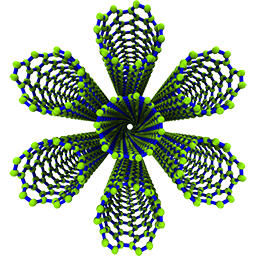compute_electronic_type¶
-
sknano.core.structures.compute_electronic_type(*Ch)[source] [edit on github][source]¶ Compute nanotube electronic type.
New in version 0.2.7.
The electronic type is determined as follows:
if \((2n + m)\,\mathrm{mod}\,3=0\), the nanotube is metallic.
if \((2n + m)\,\mathrm{mod}\,3=1\), the nanotube is semiconducting, type 1.
if \((2n + m)\,\mathrm{mod}\,3=2\), the nanotube is semiconducting, type 2.
The \(x\,\mathrm{mod}\,y\) notation is mathematical shorthand for the modulo operation, which computes the remainder of the division of \(x\) by \(y\). So, for example, all armchair nanotubes must be metallic since the chiral indices satisfy: \(2n + m = 2n + n = 3n\) and therefore \(3n\,\mathrm{mod}\,3\) i.e. the remainder of the division of \(3n/3=n\) is always zero.
Note
Mathematically, \((2n + m)\,\mathrm{mod}\,3\) is equivalent to \((n - m)\,\mathrm{mod}\,3\) when distinguishing between metallic and semiconducting. However, when distinguishing between semiconducting types, one must be careful to observe the following convention:
- Semiconducting, type 1 means:
- \((2n + m)\,\mathrm{mod}\,3=1\)
- \((n - m)\,\mathrm{mod}\,3=2\)
- Semiconducting, type 2 means:
- \((2n + m)\,\mathrm{mod}\,3=2\)
- \((n - m)\,\mathrm{mod}\,3=1\)
Parameters: *Ch – Either a 2-tuple of ints or 2 integers giving the chiral indices of the nanotube chiral vector \(\mathbf{C}_h = n\mathbf{a}_1 + m\mathbf{a}_2 = (n, m)\).
Returns: Return type: str- Semiconducting, type 1 means:
